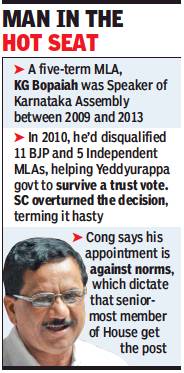Karnataka: political history
This is a collection of articles archived for the excellence of their content. |
Contents
|
Historical political icons
From: Naheed Ataullah & Rakesh Prakash, May 16, 2018: The Times of India
See graphic:
Karnataka’s historical political icons
State flag
The demand, in brief
Johnson T A, July 19, 2017: The Indian Express
Why the flag of Kannada pride has triggered a row
A longstanding demand by Kannada activists for an official state flag exploded into a major controversy on Tuesday, triggering allegations of subverting the Tricolour, and playing the political field ahead of Assembly elections. While Chief Minister Siddaramaiah maintained that nothing unconstitutional was afoot and dared the BJP to publicly reject the demand for an official flag for Karnataka, lost in the political noise were the realities of Kannada subnationalism, and the distinction, articulated by a Home Ministry official in New Delhi, between the “people” and the “state”.
The background
In 2014, Patil Puttappa, a 96-year-old veteran journalist and Kannada activist, and Bheemappa Gundappa, a 56-year-old RTI activist, made a demand for an official flag for Karnataka. On June 6 this year, the Kannada and Culture Department of the state government notified the setting up of a nine-member committee to examine the feasibility and legal issues around the demand. The matter had been reported in the local media at the time, but it was picked up again, and projected as an effort by Karnataka’s Congress government to subvert the national flag and the laws that allow only Jammu and Kashmir to have its own flag. Attack, counterattack BJP MP Shobha Karandlaje alleged the government was “going against the nation” by setting up the committee to look into the demand for a state flag. BJP leaders alleged that the Congress was trying to whip up Kannada pride ahead of the 2018 elections. Janata Dal (Secular) leader H D Kumaraswamy said there is no provision in the Constitution for a state flag. “The Congress government is using this issue to divert attention from some recent controversies,” he said.
Chief Minister Siddaramaiah, who has often sided with pro-Kannada activists on issues of local pride, rejected the allegations. “We have constituted a committee to look at the issues in the creation of a state flag. Based on the recommendations of the committee we will take a decision. Karnataka already has an official state song and there is a feeling that there is nothing wrong in having a state flag,” he said. “Having a state flag will not disrupt the unity and integrity of the country and will not reduce the stature of the national flag,” the Chief Minister added. “The national flag will always fly higher that the state flag, there are no two ways about it. Most importantly, the Constitution of India does not ban such flags,” he said.
“An attempt has been made to create a controversy. It is wrong of BJP leaders to spread misinformation. Let them state publicly that there is no need for an official flag for Karnataka. The committee has not been constituted with the Assembly elections in mind. The polls are scheduled only for May next year,” Siddaramaiah said. The committee is yet to meet to discuss the issue, said G S Siddaramayya, chairman of the Kannada Development Authority, who is part of the nine-member panel. In New Delhi, however, the leadership of Siddaramaiah’s own party betrayed nervousness at the turn of events. Sources in the Congress said the party high command felt the issue could be used by the BJP to attack it. It was “out of the question” for the Congress to accept a separate flag, a senior leader said. AICC general secretary in charge of Karnataka, K C Venugopal, said: “The Chief Minister has already given a clarification. They have not decided anything. The Culture Department of the state has set up the panel. It is not at the Chief Minister’s level. The committee will see whether the demand is admissible… legal points have to be looked into… The BJP wants to create a problem.”
A flag since the 60s
Incidentally, Karnataka has had an unofficial state flag since the mid 1960s when pro-Kannada groups were agitating against the screening of non-Kannada films in the state. The red and yellow flag was created by Kannada writer and activist Ma Ramamurthy for a pro-Kannada political party called the Kannada Paksha, after he observed that many parties representing non-Kannadigas had flags of their own. This unofficial flag is flown every year on November 1, Karnataka’s foundation day, and is a common sight at public places. Pro-Kannada activists have virtually adopted the red and yellow flag as a symbol of state pride. During agitations and protests like those over the sharing of Cauvery water with Tamil Nadu, the red and yellow banner often serves as protection against attacks by mobs — and private vehicles fly the flag in an attempt at ensuring safe passage for themselves. BJP flip-flop
In 2012, Karnataka’s BJP government accorded official status to the Karnataka flag through a notification. Chief Minister D V Sadananda Gowda said in his 2012 Budget speech that it would be compulsory to hoist the state flag on government buildings, schools and colleges. However, Kannada activist Prakash Shetty went to the High Court saying that rival activist T A Narayana Gowda was misusing the state flag for personal gain. During the hearing of the case, the then Chief Justice of Karnataka High Court, Vikramajit Sen, raised questions on the legality of states having their own flags when the law permitted only the national flag to be flown officially. The government then said it would not make it mandatory to fly the state flag. Eventually, on October 4, 2012, it withdrew the notification ordering the hoisting of the Kannada flag on government offices on November 1. People and state
In New Delhi, a Home Ministry official told reporters that “We are one nation, one flag”, but “legally, there is no provision either for providing or prohibiting a separate flag for any state”. This issue had been raised earlier too, but such a flag only represents “the people and not the state”, the official said. The Kannada flag was not raised on Republic Day or Independence Day, but on occasions like the state’s foundation day, Ministry sources noted.
February 2018/ Karnataka’s State Flag proposal
February 8, 2018: The Indian Express
If adopted with clearance from the MHA, Karnataka will be the second state after Jammu and Kashmir to have an official state flag. Karnataka has had an unofficial state flag since the mid-1960s, used to signify local pride.
A committee constituted last June by the Kannada and Culture department of the Karnataka government to examine the feasibility of having a separate flag for the state has submitted its report, recommending an official three-coloured flag to replace an unofficial two-coloured one currently used to signify local pride.
Led by chairman of Kannada Development Authority G S Siddaramaya, the nine-member committee has recommended a flag with the yellow and red of the unofficial flag to be separated by white in the middle with the state symbol on it.
Karnataka Chief Minister Siddaramaiah said the issue will be put up for consideration by the state cabinet before it is forwarded to the Union Ministry of Home Affairs (MHA) for clearance.
The recommendation for an official flag for the state has not, however, been well-received by a few leaders of pro-Kannada groups who have built an identity by working under the banner of the unofficial red and yellow flag.
“The colors recommended for the flag by the panel is not representative of the state. We will oppose this flag if the state government accepts the recommendation,’’ veteran pro-Kannada activist Vatal Nagaraj has stated. If adopted with clearance from the MHA, Karnataka will be the second state after Jammu and Kashmir to have an official state flag.
Karnataka has had an unofficial state flag since the mid-1960s, when pro-Kannada groups, including Nagaraj’s, were agitating against screening of non-Kannada films in the state. The red-yellow flag was created by Kannada writer and activist Ma Ramamurthy for a pro-Kannada political party called the Kannada Paksha. This unofficial flag is flown every year on November 1, Karnataka’s foundation day, and is a common sight at public spaces in the state.
2018: Clearance by the cabinet
Chethan Kumar, March 8, 2018: The Times of India
It's almost official now. The proposed yellow-white-and-red flag with the state’s symbol "Gandaberunda" at the centre was formally unveiled by Chief Minister Siddaramaiah, whose cabinet is likely to clear the proposal to have a separate flag for Karnataka later in the day.
A nine-member committee had in February submitted a favourable report recommending such a flag for the state nearly nine months after it was constituted. TOI was the first to report that the proposed flag will be a Tricolour and that it would be of yellow, white and red colours, and the government on Wednesday confirmed the same design.
Officials said that the committee was of the opinion that white, symbolising peace, captures Karnataka’s image best along with the two other two colours that have become synonymous with the Kannada identity.
Another official said that the government — after the Cabinet approval — will be writing to the Ministry of Home Affairs (MHA) seeking an amendment to the Flag Code, 2002. “The government will be seeking an amendment to enable provisions of including the Karnataka flag also as one of the symbols in the Flag Code,” the official said.
If the Centre does consider and give its nod for the said amendment, Karnataka will only be the second state in the country to have its own flag after Jammu and Kashmir, which is allowed to have a symbol under Article 370 of the Constitution.
An MHA official from Delhi had told TOI earlier that while there is no provision allowing or disallowing such a flag, there has been no precedence.
“I think the issue is quite serious and it will be seriously examined by the (Union) government. A thorough examination will be required to see what kind of precedent this would set. Also, nuances like what would be the protocol and code for the flag among other issues,” he had said.
Presently, the Flag Code recognises only one flag—the Tricolour—and has rules citizens and organisations must follow to maintain its dignity. If there is an amendment made to accommodate Karnataka’s proposed flag, it will be for the first time that such a symbol has been added to the Code and may pave way for other states to also propose similar symbols in the future.
Voting pattern
1980- 2018: Voting against the national ruling party
Sandeep Moudgal, May 23, 2018: The Times of India
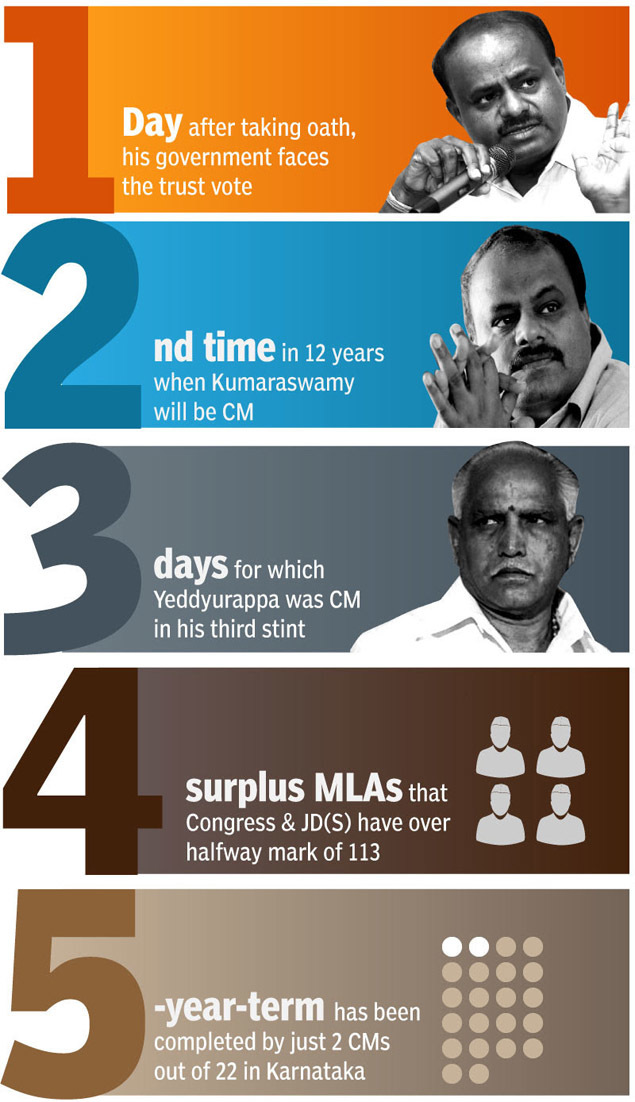
Only 2 out of 22 Karnataka CMs have completed their term.
From: Sandeep Moudgal, May 23, 2018: The Times of India

From: Sandeep Moudgal, May 23, 2018: The Times of India
HIGHLIGHTS
Karnataka is mostly ruled by a party that is in the opposition at the Centre
This time, the BJP tried to whip up a wave in favour of their saffron party, but fell short
The 55-hour tenure of BJP state president B S Yeddyurappa is just another aberration in Karnataka's 35-year-old record: the state is mostly ruled by a party that is in the opposition at the Centre.
With the exit of Yeddyurappa and the imminent ascension to power of the Congress-JD(S) combine, things are back to square one. Karnataka will be ruled by a combine that is in opposition at the Centre, and the BJP, heading the ruling coalition in New Delhi, will be sitting in the opposition in Bengaluru.
Since 1983, when Ramakrishna Hegde formed the first non-Congress government in the state, Karnataka has always proved that it swims against the national current. When Hegde's Janata Party came to power, Congress was the ruling party at the Centre.
When the Janata Dal gave way to Congress in Vidhana Soudha in 1989, the National Front led by Janata Dal's V P Singh assumed power in New Delhi.
The exceptions have been brief, like in 2013, when Congress chief minister Siddaramaiah was sworn in and UPA was in power, or when the United Front under H D Deve Gowda was ruling the nation, and Janata Dal's J H Patel was ruling the state.
Perhaps the closest effort made by any party to retain power in Karnataka and Centre at the same time was by the Congress in 2004, and the BJP in 2018. Congress chief minister S M Krishna, who was in power from 1999 to 2004, when the Atal Bihari Vajpayee-led NDA was ruling at the Centre, advanced elections by six months, sensing a wave in favour of the Congress at the national level. However, Krishna failed to attain a majority and a coalition government of Congress and JD(S) came to power, but did not last long.
A similar situation appeared to be in the making this time too. The BJP's PM Narendra Modi and party national president Amit Shah tried to whip up a wave in favour of their saffron party, and repeatedly reminded the voters of the advantages of having the state ruled by the party that was in power at the Centre too.
The party fell just short of forming a stable government. The resignation of Yeddyurappa suggested yet again that Karnataka "remains awake when the nation sleeps", according to one political analyst.
Interestingly, political analyst Sandeep Shastri cited the fractured mandate of 2018 as being "difficult to analyse".
He said the May 12 results definitely reflected that it was anti-Congress but it was not pro-BJP, thereby making it difficult to take a stance on which way Karnataka was tilting. "But it certainly indicates that in the 2019 Lok Sabha elections, Karnataka will vote individuals who should be in power rather than a party," he said.
2008, 2013, 2014: Congress vs. BJP
March 28, 2018: The Times of India
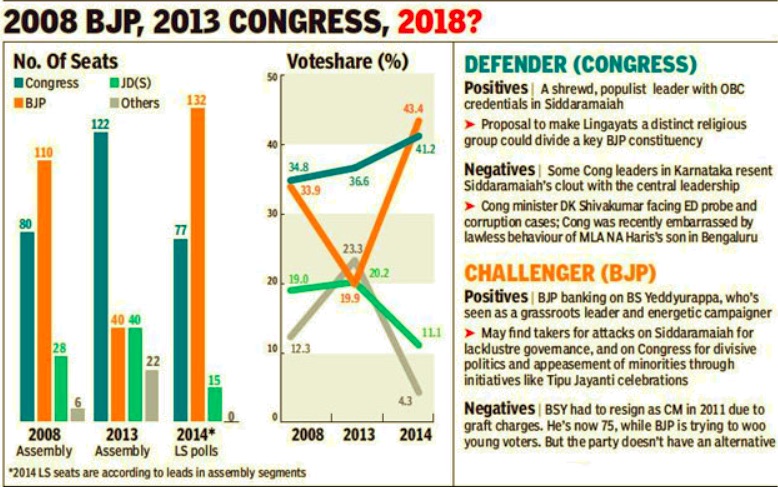
From: March 28, 2018: The Times of India

From: March 28, 2018: The Times of India

From: March 28, 2018: The Times of India
HIGHLIGHTS
Retaining Karnataka is crucial to Congress's claim to being the main anti-BJP force for the 2019 Lok Sabha polls.
BJP needs a win to regain the momentum it lost after SP and BSP came together to win two prestigious UP bypolls.
The Karnataka poll — the results of which will be announced on May 15 — is already heated with BJP and Congress keenly aware of the importance of the prize: A loss will rob Congress of one of two major states in which it is still in office while BJP needs a win to regain the momentum it lost after SP and BSP came together to win two prestigious UP bypolls despite a saffron victory in Tripura.
2013 (Assembly), 2014 (Parliament)
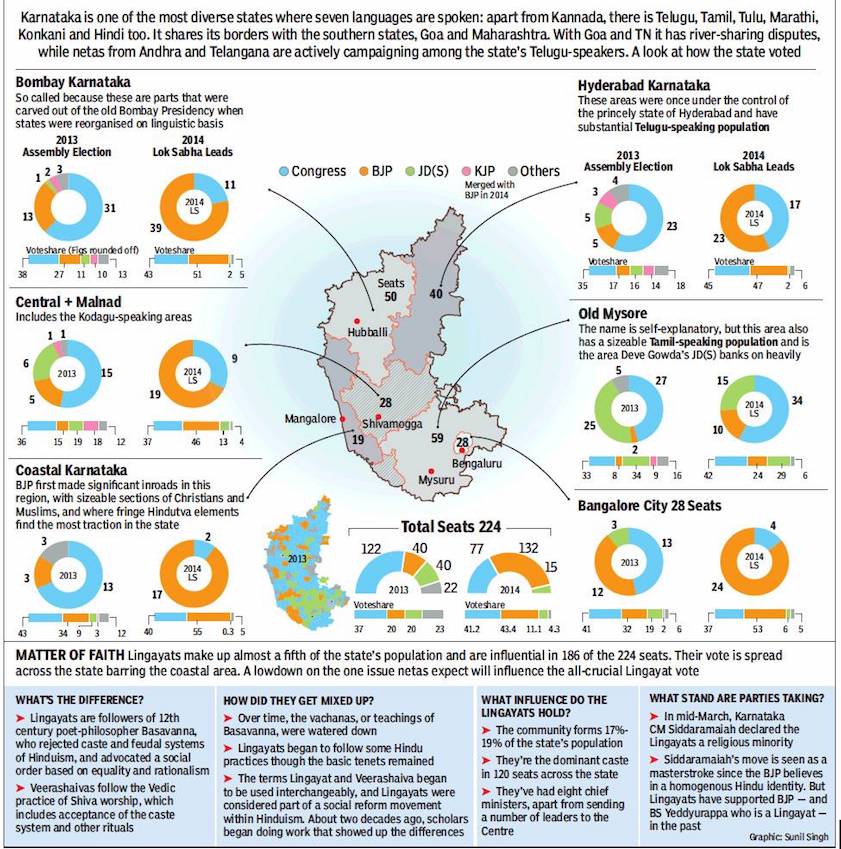
From: April 21, 2018: The Times of India
See graphic:
The pattern of voting in Karnataka in the elections of 2013 (Assembly) and 2014 (Parliament)
Year-wise events
2018
After the elections threw up no clear winner
SC holds hearing at 1.45am/ 16-17 May (2018)

From: Naheed Ataullah & Dhananjay Mahapatra, SC holds hearing at 1.45am after Cong-JD(S) asks it to block Yeddy’s swearing-in at 9am, May 17, 2018: The Times of India
Parties File Joint Petition After Governor Gives BJP 15 Days To Prove Majority In Assembly
After another day of intense political drama in Bengaluru, the action shifted to New Delhi late Wednesday night as the Congress and JD(S) moved the Supreme Court in a bid to stop B S Yeddyurappa, leader of the 104-strong BJP in the Karnataka assembly, from being sworn in as chief minister at 9am today. The 11th-hour legal manoeuvre by the newly minted alliance came after governor Vajubhai Vala invited Yeddyurappa to take oath as CM and gave him 15 days to prove his majority, a decision that instantly triggered a raging controversy because it is seen to give the BJP ample time to entice Congress and JD (S) MLAs-elect to switch sides.
SC officials gathered at the CJI’s residence and went through the petition. There was only one previous instance of the SC agreeing to a late night hearing — when a three-judge bench was set up to hear a plea seeking postponement of the death sentence awarded to Mumbai blasts convict Yakub Memon. One of the judges on that bench, Justice Dipak Misra, now the CJI, set up another three-judge bench of Justices A K Sikri, S A Bobde and Ashok Bhushan to consider the Congress-JD(S) petition. It was announced that the hearing would begin at 1.45am.
The hearing was still on at the time of going to press and it was unclear whether Congress-JD(S) would get the relief they seek. Their arguments revolve around stating that BJP has presented no evidence that it can get the additional eight MLAs it needs to reach the majority mark and the invitation to Yeddyurappa would ensure horse trading.
Congress was represented by Abhishek Manu Singhvi, BJP by former attorneygeneral Mukul Rohatgi and the Centre (read governor) by additional solicitor general Tushar Mehta.
Rohatgi and Mehta were expected to argue that the discretion of the governor cannot be challenged and there were sufficient precedents to support his decision.
Appealed only for conscience vote: BJP
In case the low-key swearingin ceremony goes ahead at Raj Bhavan, it is likely to be skipped by both Prime Minister Narendra Modi and BJP chief Amit Shah. Vala ignored the Congress-JD(S) combine’s claim that their chief ministerial nominee H D Kumaraswamy be given the first opportunity to form the government as the two parties with 116 MLAs between them enjoy a clear majority in the House, which has an effective strength of 222.
Though the decision of the governor, who served as a minister in the BJP government in Gujarat before taking up the constitutional office, was along anticipated lines, it attracted a furious response from Congress and JD(S), which accused him of shaming the Constitution. The two parties rushed to CJI Dipak Misra in the night to secure a “stay” order. They also sought a direction from the court to the governor to invite Kumaraswamy to form the government.
Seeking quashing of the governor’s decision, joint petitioners KPCC chief G Parmeshwara and JD(S) president Kumaraswamy said, “Failure of the governor to invite Congress-JD(S)-BSP alliance which together commands a clear majority of 116 legislators in the assembly is ex facie unconstitutional, illegal and arbitrary.”
Besides privileging Yeddyurappa over Kumaraswamy on the ground that BJP finished as the single largest party, the governor was also attacked for giving Yeddyurappa a fortnight to secure a vote of confidence from the assembly, with Congress alleging that the window would be used to manufacture a mandate. “Fifteen days will be used to turn 104 into 111,” former finance minister P Chidambaram said.
Earlier in the day, Kumaraswamy alleged that BJP had offered bribes of Rs 100 crore and a ministerial berth each to JD(S) MLAs to rustle up numbers. Congress also accused BJP of indulging in “horse trading” and spirited its MLAs away to a “safe house” resort in Bidadi, about 30 km south of Bengaluru, to ward off the risk of temptations trumping party loyalty. JD(S) also secured its MLAs at a five-star hotel close to Raj Bhavan.
Independent MLA R Shankar symbolised the tussle for MLAs. The lawmaker was found at Yeddyurappa’s house in the morning. By evening, he was back with the Congress-JD(S) combine and accompanied them to Raj Bhavan. Shankar, a Kuruba like outgoing CM Siddaramaiah, later said he believed the best interests of his constituents would be served by him being with the Congress.
BJP denied the “horse trading” charge and was upfront in acknowledging that it had appealed to MLAs of rival parties to exercise a “conscience vote” — shorthand for a call to defy whips issued by Congress and JD(S).
According to BJP sources, they have already identified MLAs from Congress and JD (S) who can be persuaded to “heed their conscience”. The exercise is focused on Lingayat MLAs belonging to Congress and JD(S) from north Karnataka who, the calculation goes, will have trouble accepting the leadership of Kumaraswamy, a Vokkaliga, and will, instead, prefer to support Yeddyurappa since he is from their community.
The sources admitted that organising the required numbers may not be easy, but hoped to accomplish the “challenge” because of what they called unrest among MLAs of both Congress and JD(S) over the “unnatural alliance” between the two parties.
Congress circles asserted that they would successfully fend of BJP’s efforts to take away their MLAs. “We are vigilant and capable leaders like D K Shivakumar have been given the job to protect the flock. Also, most of our MLAs won against BJP in a bitter battle and will be loath to cross over to the rival camp,” said a senior party leader in Delhi. However, he acknowledged that half a dozen JD(S) MLAs aligned with Kumarswamy’s estranged sibling Revanna could be vulnerable to “generous” offers from BJP. Congress was also not sure whether the lone BSP MLA would be steadfast in his support to the non-BJP camp.
Sriramulu emerges tallest in Ballari
Sandeep Moudgal, Sriramulu emerges tallest in Ballari, May 16, 2018: The Times of India
The Reddy brothers sealed a spectacular rehabilitation into BJP with four from the ‘Reddy group’ winning assembly seats. But it was Ballari MP B Sriramulu who capped his phenomenal rise by wresting Molkalmuru in Chitradurga, outside Ballari.
Once perceived as a lackey of the Reddy brothers, the mining barons of Ballari, the rise of Sriramulu, popularly known as Ramulu, is one for the story books. In this assembly election, seven tickets were given to the Reddys, family members and friends included. Four of them lost. But G Somasekhara Reddy (Bellary City) and G Karunakara Reddy (Harapanahalli) came out victors.
BJP went back to the Reddy brothers to help them in the assembly polls as well as the 2019 Lok Sabha election. With mining czars Anand Singh and B Nagendra, as well as the Ghorpade family, backing Congress, Reddy brothers are the sole mine runners still with BJP.
In this context, Sriramulu was a vital bridge for BJP to maintain close ties with tainted mining baron Janardhana Reddy while publicly staying aloof. As a close aide and friend of Janaradhana Reddy, Sriramulu has become an indispensable component in BJP’s scheme to take the reins of power in Karnataka.
The 46-year-old Sriramulu derives his strength from his Valmiki or Nayaka community (7-8 % of the state electorate) and can be the rallying force for the party considering there are no rivals to stake claim for leadership of the community.
Asked about the likelihood of Sriramulu becoming deputy CM in the event of BJP forming the government, BJP national president Amit Shah neither confirmed nor denied it.
Old enemies turned political friends
How old enemies turn political friends, May 16, 2018: The Times of India
Who said you need friends to form a government? Sworn enemies can bury the hatchet in a flash to for m a gover nment. For years, Congress’ Siddaramaiah has feuded with former Prime Minister and JD(S) leader H D Deve Gowda. But after Tuesday’s results in the Karnataka election, Siddaramaiah has had to accept Gowda’s leadership following a power-sharing deal hammered out by the two parties.
Siddaramaiah and Gowda have a long history — the former was once Gowda’s protégé. But in 2005, Siddaramaiah walked out of JD(S) in a huff after Gowda anointed his son H D Kumaraswamy as his successor.
It is not the first time that foes have turned friends in an effort to gain the top spot. Across the country, last-minute alliances and quick friendships have been forged to for m gover nments.
In April 2015, for instance, when Rashtriya Janata Dal chief Lalu Prasad held the hand of Janata Dal (United) supremo Nitish Kumar and declared him chief ministerial candidate, it seemed like incredible. Onetime colleagues Lalu and Nitish had a bitter falling out and the latter had joined hands with BJP to become Bihar CM for two terms. But they did come together in 2015, only to acrimoniously part ways again.
In Uttar Pradesh, Bahujan Samaj Party president Mayawati and Samajwadi Party chief Akhilesh Yadav struck an alliance for the Gorakhpur and Phulpur Lok Sabha byelections in March 2018, ending decades of rivalry and hostility. Mayawati, and Akhilesh’s father Mulayam Singh Yadav had a bitter row in 1995 when she decided to pull support from an SPled coalition government. SP cadres allegedly laid siege to the state guest house to thwart the withdrawal of support. As controversy erupted, the governor dismissed Mulayam and invited Mayawati to form the government.
Further west, Maratha strongman Sharad Pawar revolted against Sonia Gandhi over her “foreign origin” and broke from Congress to form Nationalist Congress Party in May 1999.
But, months later, in September 1999, when the Maharashtra assembly elections threw up a hung mandate, Pawar was back at the Congress’ doorstep seeking a coalition.
The Congress-NCP combine went on to rule Maharashtra for 15 years.
How CJI helped Congress
HIGHLIGHTS
The CJI urgently constituted a three-judge bench for a post-midnight hearing on the Congress-JD(S) combine’s petition which ultimately changed its political fortune
The SC registry cleared the petition at 11.40 pm on Wednesday and it reached CJI Misra’s residence at 12.10 am on Thursday
Chief Justice Dipak Misra has been at the receiving end of Congress’s veiled as well as not-so-veiled attacks since January 12 when four seniormost judges of the Supreme Court , in an extraordinary step, chose to criticise the head of the judiciary.
Congress latched on to the attack on the CJI by his colleagues and cited this to launch a drive to seek his removal. However, with the CJI swiftly responding to Congress’s plea for the top court’s intervention to stall the formation of a BJP government in Karnataka + — with many wondering whether it was his intervention that turned out to be the game changer — the opposition party’s hostility could have been neutralised to some extent.
Discharging his role as master of roster, the CJI on Thursday urgently constituted a three-judge bench for a post-midnight hearing on the Congress-JD(S) combine’s petition which ultimately changed its political fortune. The SC registry cleared the petition at 11.40 pm on Wednesday and it reached CJI Misra’s residence at 12.10 am on Thursday.
The registry needed the CJI’s order to choose judges and find their convenience to list the petition which, according to Congress lawyers, could not brook any delay in view of the governor calling BJP to form government in the state.
The CJI went through the papers quickly and at 12.20 am asked registrar general Ravindra Maithani to get in touch with three judges — Justices A K Sikri, S A Bobde and Ashok Bhushan — for an urgent hearing on the petition.
To the credit of the three judges, none of them hesitated for a postmidnight hearing in the SC. Maithani got back to the CJI with the consent of the judges that they would hear the petition at 1.45 pm. Arrangements were made to open Court No.6, ferry staff and court masters to assist the judges in the chamber and the courtroom.
Despite arrangements being made on a war footing, the hearing could start only at 2.10 am.Registry sources said the CJI was in constant touch with the registrar general. The CJI kept awake till the hearing got underway, sources said.. He was prepared to nominate a substitute for any of the judges if situation so warranted. Had the CJI deferred hearing on the petition to Thursday, BJP would have got time to “work on” rival MLAs.
Registry sources said even when the Congress-JD(S) petition challenging appointment of the pro tem speaker was mentioned before the CJI around 8.30 pm on Friday, he immediately ordered it placed before the same bench, which at 9.45 pm decided to hear it.
May 15- 18: the developments
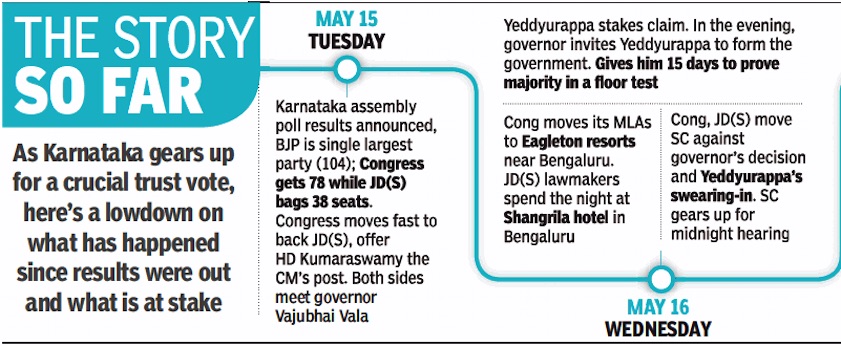
From: May 19, 2018: The Times of India
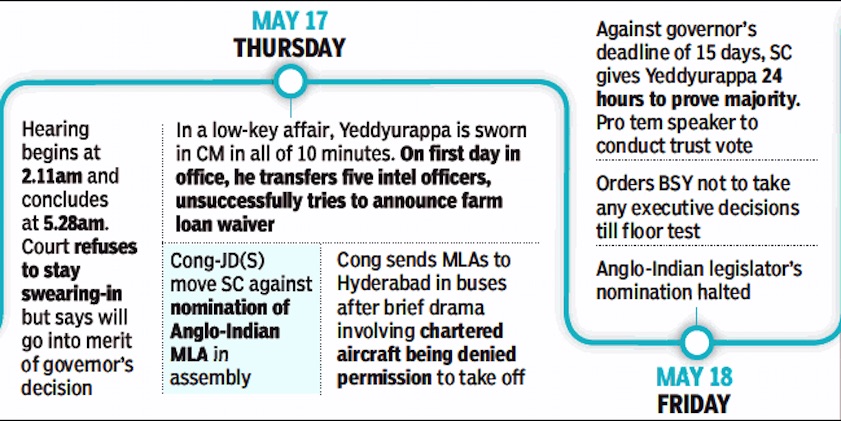
From: May 19, 2018: The Times of India
See graphics :
The developments between May 15 and 16- 2018
The developments between May 17 and 18- 2018
Appointment of BJP MLA as pro tem speaker
Cong, JD(S) move SC again, against BJP MLA as pro tem speaker, May 19, 2018: The Times of India
A fresh controversy erupted over the appointment of BJP MLA K G Bopaiah as pro tem speaker for the assembly with Congress and JD(S) claiming it went against the convention that the post should go to the seniormost member of the House — in this case, R V Deshpande of Congress.
The combine approached the Supreme Court for the second time in as many days to challenge the appointment, terming it “ex facie unconstitutional and illegal”. A bench of Justices A K Sikri, S A Bobde and Ashok Bhushan will hear the plea at 10.30am on Saturday. Bopaiah was sworn in as pro tem speaker by governor Vajubhai R Vala on Friday, within hours of the SC passing an interim order that a pro tem speaker should preside over the trust vote.
The opposition parties allege that Bopaiah was picked because of his antecedents in handling trust votes in a controversial manner. They said Bopaiah had been hauled up by the SC for irregularly disqualifying MLAs during B S Yeddyurappa’s earlier stint as CM. BJP, however, defended the appointment with Union minister Prakash Javadekar tweeting, “K G Bopaiah was appointed pro tem speaker even in 2008 by the then governor. That time Bopaiah was 10 years younger than what he is today. The Congress is thus raising hoax objection. The appointment of Bopaiah Ji is as per rules and regulations.”
The five-term MLA representing Virajpet in Madikeri district will administer oath to 220 newly elected MLAs (JD-S leader H D Kumaraswamy has been elected from two seats and will have to vacate one of them).
Subsequently, he will conduct the trust vote to be moved by CM B S Yeddyurappa. This is perhaps the first time in Karnataka’s legislative history that a pro tem speaker will oversee a trust vote.
Statute mum on pro tem speaker pick
At the meeting held with Congress leaders, 77 of the 78 MLAs were present, indicating no break in their ranks, for now. The lawmakers are expected back in the state capital by early next morning.
The BJP also herded its MLAs into Shangri-la hotel in Bengaluru, the same one used by JD(S) earlier in the week for its MLAs. All, including city MLAs, are expected to be there tonight.
As on the previous two days, rumour mills were abuzz through the day: about Lingayat MLAs of the JD(S)- Congress alliance being in touch with the BJP, and Vokkaliga MLAs in the saffron party cozying up to the combine owing to caste sentiments. The parties rubbished such reports.
The Constitution is silent on who should be appointed the pro tem speaker, though the honour of administering oath to newly-elected MLAs, by convention, goes to the seniormost member of the House. Congress instantly screamed foul, saying the responsibility should have been assigned to R V Deshpande, its veteran MLA who won his eighth term.
The Congress-JD(S) combine moved the SC again, this time expressing fear that Bopaiah might disqualify its members, and sought a directive to the pro tem speaker not to “take up any agenda other than administration of oath and the floor test”.
Union minister Prakash Javadekar refuted the ‘seniority’ convention and pointed out that Bopaiah had been made pro tem speaker by the then governor in 2008 when he was 10 years younger.
Importantly, through its latest petition, which the SC will hear at 10.30am on Saturday, Congress renewed its demand for segregating MLAs supporting and opposing the trust motion in different lobbies. The court had not heeded the demand when it was raised in the morning, and had said the matter should be left to the pro tem speaker. The reiteration of the plea brought out Congress’s fear of defections, although it claimed that except for Anand Singh, all its MLAs had been accounted for. This will be the third floor test that Yeddyurappa will face. In 2007, he resigned ahead of the floor test after JD(S) leadership refused to extend support to his government and in 2011, he comfortably won.
Yeddyurappa exuded confidence, saying he would win the floor test easily and insisted that many Congress-JD(S) MLAs would vote in his favour. “We welcome the Supreme Court ruling... we have already got support of 120 MLAs including 16 from Congress and JD(S) camps and are confident of proving our majority,” Yeddyurappa’s close aide and Udupi-Chikkamagalur MP Shobha Karandlaje said.
There was further drama when Congress released an audio recording of a conversation allegedly between discredited mining baron G Janardhana Reddy and Congress MLA from Raichur Rural (ST) constituency Basannagouda Daddal, in which the former was allegedly heard offering the latter a ministerial post and other inducements and giving examples of two others in the past who he had brought to BJP and helped thrive.
Deve Gowda, Kharge return to centre stage
This week, two Kannadiga veterans have returned from the sidelines to bask in the glory that was considered past them.
Mallikarjun Kharge, the Congress face from Karnataka, and former PM H D Deve Gowda of JD (S), are being talked about in political circles after their promotion on the national stage.
22 years after the “fumble harmer” became the prime minister, and following many years of diminishing profile that was viewed as his fading away, Gowda is suddenly back to holding forth on national politics — he is speaking about the dynamics of ‘grand opposition alliance” for 2019.
The rejuvenation of the fading patriarch stems from his son HD Kumaraswamy’s unlikely ascension to chief ministership of Karnataka.
Gowda turned Kumaraswamy’s swearing-in into an opposition jamboree, with anti-BJP satraps from Mamata Banerjee to Mayawati and Akhilesh Yadav to Congress brass led by Sonia Gandhi descending on the venue. It became a show of strength of the “secular alliance”.
Mirroring the spike in the fortunes of his foe from Karnataka assembly, Kharge has become the AICC general secretary, entrusted with the task of the important state of Maharashtra. The weighty organisational assignment added to his portfolio of leader of Congress in Lok Sabha and chairman of the Public Accounts Committee of Parliament. For Gowda, there has been no looking back since his son presided over the opposition show in Bengaluru last month. Many feel Gowda senses that situation in 2018 is similar to 1996 when fate pitchforked him onto the national scene.
A satrap who signed on Gowda’s election as PM explained that he benefitted from North Indian leaders — Mulayam Singh Yadav, Lalu Prasad, Ajit Singh, Sharad Yadav, Ram Vilas Paswan et al — refusing to agree on each other’s candidature. It was plain envy or overlapping political constituencies. A Congress leader from Karnataka said Gowda recently told his supporters that he would “lead the Mahayuti” in 2019.
In case of Kharge, the AICC appointment triggered speculations if it meant that he would quit the post of party leader in LS and Rahul Gandhi will take charge himself. But Congress managers denied the possibility.
See also
And also
Karnataka: Assembly elections, 2018
Karnataka: caste, mutts and elections
Karnataka: Parliamentary elections
Karnataka: political history
